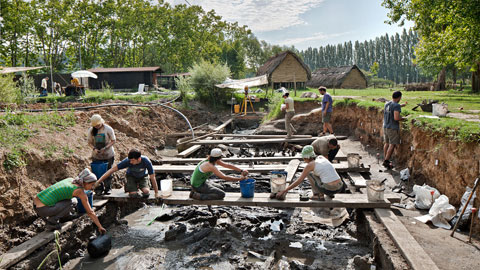Banyoles, new headquarters of the UAB Archaeology Campus

26/11/2014
The rector of the UAB, Ferran Sancho, declared that “research is not only generation of knowledge, but also a way of putting Catalonia, and in this case Banyoles, on the map and explaining it to society”. “Due to its extraordinary conditions of preservation of the La Draga site, students will be able to develop the most advanced techniques in the analysis of archaeological remains”, points out Raquel Piqué, lecturer of the UAB Department of Prehistory and promoter of the new campus.
The mayor of Banyoles, Miquel Noguer, highlighted the importance of the site and “the continuity of the project, where students from the UAB and also from around the world have come and have discovered our city”.
The Neolithic park includes specific facilities such as bungalows and laboratories, which facilitate conducting fieldwork and the analysis of materials. It also houses informative facilities such as replicas of Neolithic cabins, from which students can learn more about this aspect of archaeology. The Banyoles Archaeology Campus will also include specific working areas and material analysis laboratories at the Archaeology Museum of Banyoles.
The Neolithic people of La Draga, Banyoles
La Draga is an archaeological site corresponding to the place in which one of the first farming communities settled in the north-east of the Iberian Peninsula. The site is located on the eastern part of the Banyoles Lake and dates back to 5400 and 5000 BCE. The site occupies 8000 sq m and stretches out 100 m along the lake's shore and 80 m wide towards the east. Part of the site, the old Neolithic beach, is totally submerged in the lake, while other parts are located on solid ground.
The site at La Draga is exceptional for several reasons. Firstly, due to its antiquity, which is considered to be one of the oldest of the Neolithic period existing in the Iberian Peninsula. Secondly, because it is an open-air site with a fairly continuous occupation. Lastly, and surely most remarkable, because of the exceptional conditions in which it is conserved. The archaeological levels are located in the phreatic layer surrounding Lake Banyoles, giving way to anaerobic conditions which favour the conservation of organic material. These circumstances make La Draga a unique site in all of the Iberian Peninsula, since it is the only one known to have these characteristics. In Europe, together with Dispilo in Greece and La Marmota in Italy, it is one of the few lake settlements from the 6th millennium BCE.
The digs have always been conducted under the leadership of the Archaeological Museum of Banyoles, with the participation of the Universitat Autònoma de Barcelona, the Spanish National Research Council ((IMF, Barcelona) and the Archaeological Museum of Catalonia.